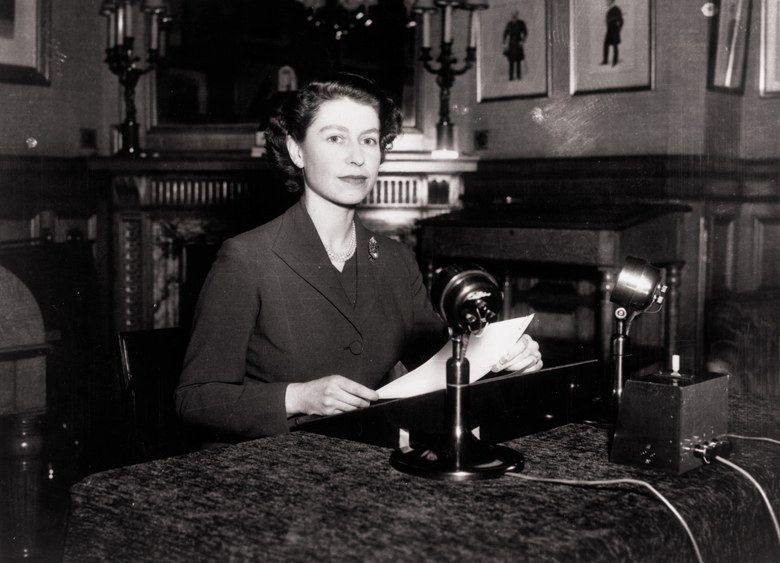英国女王伊丽莎白二世最令人难忘的圣诞节致辞
编辑:给力英语 更新:2017年12月25日 作者:Elise Taylor

Queen Elizabeth II making her first ever Christmas broadcast to the nation in 1952 from Sandringham.
Queen Elizabeth’s Most Memorable Christmas Speeches
Every December 25, millions of people across the United Kingdom gather around their televisions to watch the Queen’s Christmas Broadcast (formally known as “Her Majesty’s Most Gracious Speech”). She speaks from her living room in Buckingham Palace for only a few minutes. But in those few minutes, she talks about herself, her family, the Commonwealth. She may read a bible verse or a poem. And she ties it all together with a theme—reconciliation, service, inspiration—that reflects on the previous year and enlightens the next one.
This Christmas marks the Queen’s 65th speech. A lot has changed since her first speech from Sandringham to her 2016 one from Buckingham Palace, and there have been many milestones during her six-decade broadcast reign.
The head of the British monarchy has broadcast a speech on Christmas Day ever since 1932, when King George V gave a message to inaugurate the BBC World Service.
It was initially intended to be a one-off, but proved so popular that the King spoke every festive season until his death five years later.
There was no Christmas speech in 1936, following the abdication of King Edward VIII, though King George VI resumed the tradition in 1937.
Queen Elizabeth II picked up the tradition and has given a speech every year since, apart from in 1969 when she released a written message.
1952
1952 was Queen Elizabeth’s first Christmas as Queen. It was also her first Christmas without her father. She made her first speech over the radio, sitting in his same chair and desk. (At that time, the speech was done at Sandringham. It would later switch to Buckingham Palace.)
“Each Christmas, at this time, my beloved father broadcast a message to his people in all parts of the world. Today I am doing this to you, who are now my people,” she began. ”My father, and my grandfather before him, worked all their lives to unite our peoples ever more closely, and to maintain its ideals which were so near to their hearts. I shall strive to carry on their work.”
She ended with a request for prayer—not for the country, but for herself, on her Coronation Day that June. “You will be keeping it as a holiday; but I want to ask you all, whatever your religion may be, to pray for me on that day—to pray that God may give me wisdom and strength to carry out the solemn promises I shall be making, and that I may faithfully serve him and you, all the days of my life.”
Up until 1957, the Queen’s speech was audio only, both on radio and television. But thanks to some prodding by the BBC, and perhaps outspoken monarchy reformist Lord Altrincham, 1957 became the first year she televised her address. Richard Webber, head of outside broadcast at the time, wrote for The Guardian: “We asked the Palace if the Queen would consider reading the message live on television. She was a young monarch keen to enter into the spirit of the new era, and approved of the idea.”
That Christmas, at 3:00 p.m., people could see the Queen, her mannerisms, and inside her home. It’s often cited as one of the most important ways Queen Elizabeth has modernized the monarchy. But using a new medium presented unique challenges. “During her broadcast she refers to lines from John Bunyan’s The Pilgrim’s Progress, and picks up a book from her desk. The lines were printed on a sheet of paper inserted inside the book,” Webber recalled. “However, in the run-through, the Queen quickly spotted that it wasn’t the right book and asked whether there was a copy in the library. Sure enough, there was. I’m sure viewers wouldn’t have noticed but full marks to the Queen for thinking about it.”
1980
A new decade brought a new viewership record: More than 28 million people tuned into the Queen’s Christmas broadcast in 1980, which honored the Queen Mother’s 80th birthday.
After the divorces of three out of her four children and a terrible fire that destroyed much of Windsor Castle, the Queen called 1992 her “annus horribilis.” She spoke of her troubles in her 1992 Christmas message: “Like many other families, we have lived through some difficult days this year. The prayers, understanding, and sympathy given to us by so many of you, in good times and bad, have lent us great support and encouragement. It has touched me deeply that much of this has come from those of you who have troubles of your own.” Except, that year, most people already knew what she was going to say—British tabloid The Sun leaked her message two days early. The Queen sued, and was awarded 200,000 pounds in damages (which she promptly donated to charity).
1997 was the year Princess Diana died, a tragic event that the Queen was accused of mishandling (many thought she should have returned to London as soon as the news broke, rather than staying at Balmoral). Her emotional 1997 speech was meant to dispel that perception. “We all felt the shock and sorrow of Diana’s death. Thousands upon thousands of you expressed your grief most poignantly in the wonderful flowers and messages left in tribute to her,” she said, as the screen flashed pictures of flower tributes left in front of Buckingham and Kensington Palace. “That was a great comfort to all those close to her.” At 9 minutes and 50 seconds, it was the longest Christmas message ever by a British monarch.
It was also the first one to be posted on the Internet.
Last year’s Christmas message focused on British Olympians and the small acts of greatness regular Brits do every day. But the real milestone of this speech wasn’t the text itself, but the technology: It was the first speech to be broadcast in 3-D.